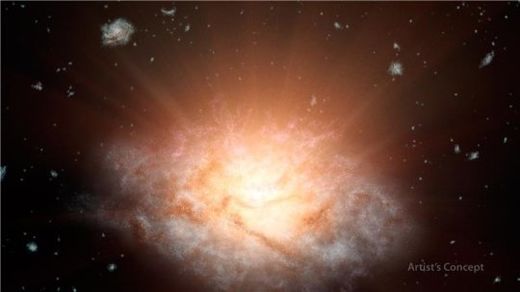"We are looking at a very intense phase of galaxy evolution," said Chao-Wei Tsai of NASA's Jet Propulsion Laboratory in Pasadena, California, lead author of a new report appearing in the 22 May issue of The Astrophysical Journal. "This dazzling light may be from the main growth spurt in the size of the galaxy's black hole"
Professor Andrew Blain, from the University of Leicester's Department of Physics and Astronomy, has been involved with WISE since its inception in 2001, and has been responsible for examining and validating the data from the WISE telescope. He is a co-author of the new report into this discovery.
The galaxy, known as WISE J224607.57-052635.0, may have a behemoth black hole at its belly, gorging itself on gas.
Supermassive black holes grow by drawing gas and matter into a disk around them. The disk heats up to beyond-sizzling temperatures of millions of degrees, blasting out high-energy, visible, ultraviolet, and X-ray light. The light is blocked by surrounding cocoons of dust. As the dust heats up, it radiates infrared light.
Immense black holes are common at the cores of galaxies, but finding one this big so far back in the cosmos is rare. Because light from the galaxy hosting the black hole has traveled 12.5 billion years to reach us, astronomers are seeing the object as it was in the past.The black hole was already billions of times the mass of our sun when our universe was only a tenth of its present age of 13.8 billion years.
"The massive black holes in ELIRGs could be gorging themselves on more matter for a longer period of time," said Professor Blain. "It's like winning a hot-dog-eating contest lasting hundreds of millions of years."
More research is needed to solve this puzzle of these dazzlingly luminous galaxies. The team has plans to better determine the masses of the central black holes. Knowing these objects' true hefts will help reveal their history, as well as that of other galaxies in this very crucial and frenzied chapter of our cosmos.
WISE has been finding hundreds of other, similar oddball galaxies from infrared images of the entire sky it took in 2010. By viewing the whole sky with more sensitivity than ever before, WISE has been able to catch rare cosmic specimens that might have been missed otherwise.
The new study reports a total of 20 new ELIRGs, including the most luminous galaxy found to date. These galaxies, which are even more luminous than the ultraluminous infrared galaxies (ULIRGs) reported before, were not found earlier because of their distance, and because dust converts their powerful visible light into an incredible outpouring of infrared light.
"We found in a related study with WISE that as many as half of the most luminous galaxies only show up well in infrared light," said Tsai.
NASA's Jet Propulsion Laboratory, Pasadena, California, manages, and operates, WISE for NASA's Science Mission Directorate. The spacecraft was put into hibernation mode in 2011 after it scanned the entire sky twice, completing its main objectives. In September 2013, WISE was reactivated, renamed NEOWISE and assigned a new mission to assist NASA's efforts to identify potentially hazardous near-Earth objects.
Journal Reference:
- Chao-Wei Tsai, Peter Eisenhardt, Jingwen Wu, Daniel Stern, Roberto Assef, Andrew Blain, Carrie Bridge, Dominic Benford, Roc Cutri, Roger Griffith, Thomas Jarrett, Carol Lonsdale, Frank Masci, Leonidas Moustakas, Sara Petty, Jack Sayers, S. Adam Stanford, Edward Wright, Lin Yan, David Leisawitz, Fengchuan Liu, Amy Mainzer, Ian McLean, Deborah Padgett, Michael Skrutskie, Christopher Gelino, Charles Beichman, Stéphanie Juneau. The Most Luminous Galaxies Discovered by WISE. The Astrophysical Journal, 2015 [link]




Infrared?
Under our noses the whole time. Our dark energy is hidden in dust.